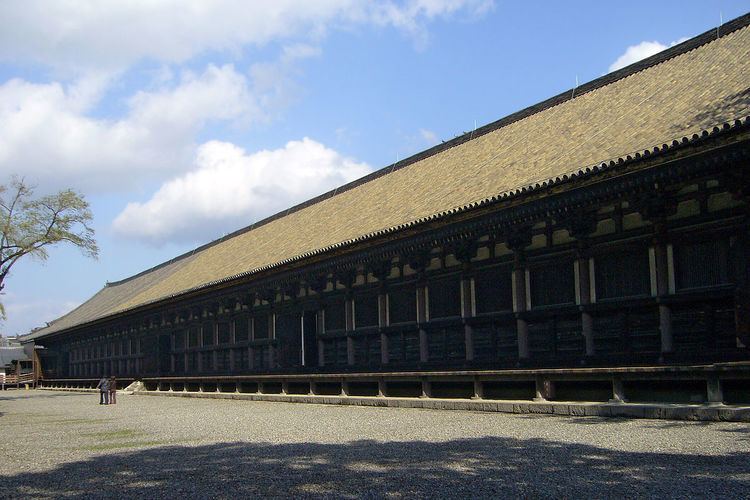Phone +81 75-561-0467 | ||
 | ||
Similar Kiyomizu‑dera, Nijō Castle, Ginkaku‑ji, Kinkaku‑ji, Fushimi Inari‑taisha | ||
Autumn in kyoto 2014 1 of 5 sanj sangen d
Sanjūsangen-dō (三十三間堂, lit. thirty-three ken (length) hall) is a Buddhist temple in Higashiyama District of Kyoto, Japan. Officially known as "Rengeō-in" (蓮華王院), or Hall of the Lotus King, Sanjūsangen-dō belongs to and is run by the Myoho-in temple, a part of the Tendai school of Buddhism. The temple name literally means Hall with thirty three spaces between columns, describing the architecture of the long main hall of the temple.
Contents
- Autumn in kyoto 2014 1 of 5 sanj sangen d
- History
- Important features
- Guardian deities and Hinduism
- References
History
Taira no Kiyomori completed the temple under order of Emperor Go-Shirakawa in 1164. The temple complex suffered a fire in 1249 and only the main hall was rebuilt in 1266. In January, the temple has an event known as the Rite of the Willow (柳枝のお加持), where worshippers are touched on the head with a sacred willow branch to cure and prevent headaches. A popular archery tournament known as the Tōshiya (通し矢) has also been held here, beside the West veranda, since the Edo period. The duel between the famous warrior Miyamoto Musashi and Yoshioka Denshichirō, leader of the Yoshioka-ryū, is popularly believed to have been fought just outside Sanjūsangen-dō in 1604.
Important features
The main deity of the temple is Sahasrabhuja-arya-avalokiteśvara or the Thousand Armed Kannon. The statue of the main deity was created by the Kamakura sculptor Tankei and is a National Treasure of Japan. The temple also contains one thousand life-size statues of the Thousand Armed Kannon which stand on both the right and left sides of the main statue in 10 rows and 50 columns. Of these, 124 statues are from the original temple, rescued from the fire of 1249, while the remaining 876 statues were constructed in the 13th century. The statues are made of Japanese cypress clad in gold leaf. Around the 1000 Kannon statues stand 28 statues of guardian deities. There are also two famous statues of Fūjin and Raijin.
Guardian deities and Hinduism
The 28 guardian deities stand in front of the Buddhist Kannon have their origins in Sanskrit texts of Hinduism. These ideas came to Japan through China, and the presence of both Hindu and Buddhist deities at Sanjūsangen-dō temple in Kyoto suggest various theories of the origin and spread of the spiritual and cultural ideas from India to east Asia.
Life-size statues of these deities are housed at Sanjūsangen-dō where they guard the principal statue of the 11 feet tall seated Senju Kannon. The temple also features 1,000 standing statues of the Senju Kannon. The deities at Sanjūsangen-dō include Naraenkengo-ou, Misshaku-kongorikishi, Touhou-ten, Birurokusha-tennou, Birubakusha-tennou, Bishamonten, Daibon-tennou, Taishaku-ten, Daibenkudoku-ten, Mawara-ou, Jinmo-ten, Konpira-ou, Manzensha-ou, Hippakara-ou, Gobujyogo-ten, Konjikikujyaku-ou, Sanshitai-sho, Nandaryu-ou, Sakararyu-ou, Karura-ou, Kondai-ou, Mansen-ou, Magoraka-ou, Makeishura-ou, Kendabba-ou, Ashura-ou, Kinnara-ou and Basusennin. These deities trace their origins to Hindu mythology, and correspond to Varuna, Vishnu, Lakshmi, Brahma, Shiva, Garuda, Vayu, Narayana, Indra and others.
